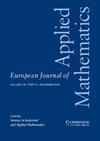Characterising small objects in the regime between the eddy current model and wave propagation
IF 1.1
4区 数学
Q1 MATHEMATICS, APPLIED
引用次数: 0
Abstract
Being able to characterise objects at low frequencies, but in situations where the modelling error in the eddy current approximation of the Maxwell system becomes large, is important for improving current metal detection technologies. Importantly, the modelling error becomes large as the frequency increases, but the accuracy of the eddy current model also depends on the object topology and on its materials, with the error being much larger for certain geometries compared to others of the same size and materials. Additionally, the eddy current model breaks down at much smaller frequencies for highly magnetic conducting materials compared to non-permeable objects (with similar conductivities, sizes and shapes) and, hence, characterising small magnetic objects made of permeable materials using the eddy current at typical frequencies of operation for a metal detector is not always possible. To address this, we derive a new asymptotic expansion for permeable highly conducting objects that is valid for small objects and holds not only for frequencies where the eddy current model is valid but also for situations where the eddy current modelling error becomes large and applying the eddy approximation would be invalid. The leading-order term we derive leads to new forms of object characterisations in terms of polarizability tensor object descriptions where the coefficients can be obtained from solving vectorial transmission problems. We expect these new characterisations to be important when considering objects at greater stand-off distance from the coils, which is important for safety critical applications, such as the identification of landmines, unexploded ordnance and concealed weapons. We also expect our results to be important when characterising artefacts of archaeological and forensic significance at greater depths than the eddy current model allows and to have further applications parking sensors and improving the detection of hidden, out-of-sight, metallic objects.描述小物体在涡流模型和波传播之间的状态
能够在低频下表征物体,但在麦克斯韦系统涡流近似的建模误差变得很大的情况下,对于改进当前的金属探测技术非常重要。重要的是,随着频率的增加,建模误差会变得很大,但涡流模型的准确性也取决于物体的拓扑结构和材料,与相同尺寸和材料的其他几何形状相比,某些几何形状的误差要大得多。此外,与非渗透性物体(具有相似的导电性、尺寸和形状)相比,高导磁材料的涡流模型在更小的频率下破裂,因此,使用金属探测器在典型操作频率下的涡流来表征由渗透性材料制成的小型磁性物体并不总是可能的。为了解决这个问题,我们推导了一个新的可渗透高导电性物体的渐近展开式,该展开式适用于小物体,不仅适用于涡流模型有效的频率,而且适用于涡流建模误差变大且应用涡流近似无效的情况。我们导出的首阶项导致了基于极化张量对象描述的新形式的对象特征,其中的系数可以通过求解矢量传输问题来获得。我们期望这些新的特性在考虑距离线圈较远的物体时很重要,这对于安全关键应用很重要,例如识别地雷,未爆弹药和隐藏武器。我们还希望我们的结果在描述比涡流模型所允许的更深深度的考古和法医意义的文物时是重要的,并且在停车传感器和改进对隐藏的,视线之外的金属物体的检测方面有进一步的应用。
本文章由计算机程序翻译,如有差异,请以英文原文为准。
求助全文
约1分钟内获得全文
求助全文
来源期刊
CiteScore
4.70
自引率
0.00%
发文量
31
审稿时长
>12 weeks
期刊介绍:
Since 2008 EJAM surveys have been expanded to cover Applied and Industrial Mathematics. Coverage of the journal has been strengthened in probabilistic applications, while still focusing on those areas of applied mathematics inspired by real-world applications, and at the same time fostering the development of theoretical methods with a broad range of applicability. Survey papers contain reviews of emerging areas of mathematics, either in core areas or with relevance to users in industry and other disciplines. Research papers may be in any area of applied mathematics, with special emphasis on new mathematical ideas, relevant to modelling and analysis in modern science and technology, and the development of interesting mathematical methods of wide applicability.

 求助内容:
求助内容: 应助结果提醒方式:
应助结果提醒方式:


